#bbc verify
Explore tagged Tumblr posts
Text
by David Collier
BBC Verify is promoted as BBC’s flagship ‘fact checking’ news service. But as you will see below – BBC Verify is a cheap, amateurish, propaganda device- that is driven by unacceptable bias, and publishes blatant lies worthy of a Russian Soviet era misinformation service.
BBC Verify ‘verifies’ the Iranian missile strike
On Tuesday evening, 1 October 2024, Iran fired approximately 180 ballistic missiles at Israel. Many were intercepted, but several sites were hit. On Wednesday evening BBC Verify published a 1 minute 20 second video – titled ‘where Iran’s missiles struck in Israel’.
The BBC Verify team tells us they have been looking at ‘where Iran’s missiles have landed’ and the video is to counter ‘a lot of false imagery’ being circulated online. They say they managed to verify strikes in the vicinity of three key locations – all of them military sites:

This creates an immediate problem. Why only these three? For example, a verified strike by Ramat Gan shopping mall has not been included. The BBC had reported on this – and so were well aware of it – but for some reason, BBC Verify left the shopping mall strike out of their analysis.
It is difficult to escape the conclusion that BBC Verify were deliberately pushing a pro-Iranian propaganda line that the missiles were fired only at military targets.
But it gets a lot, lot worse.
62 notes
·
View notes
Text
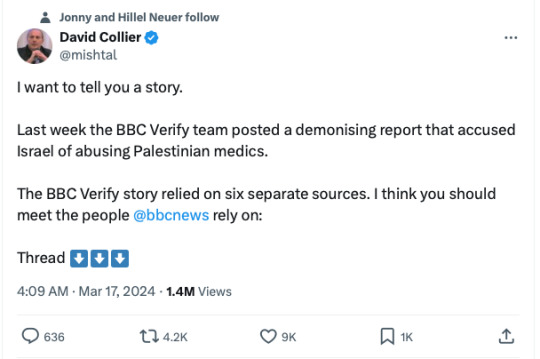
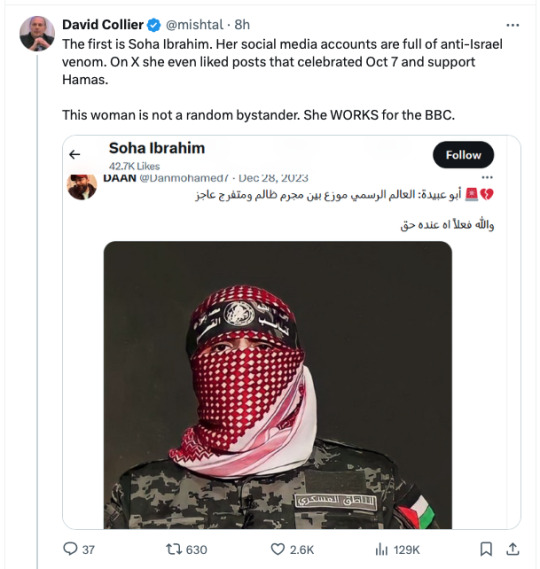

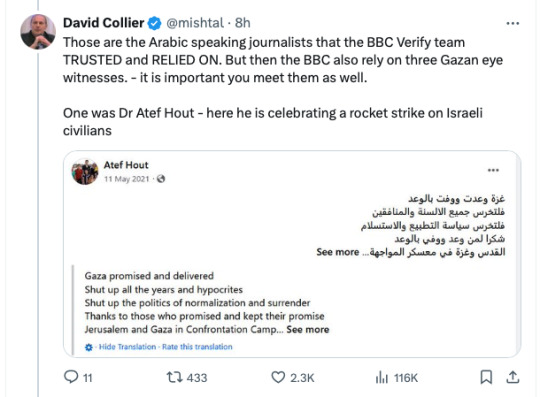
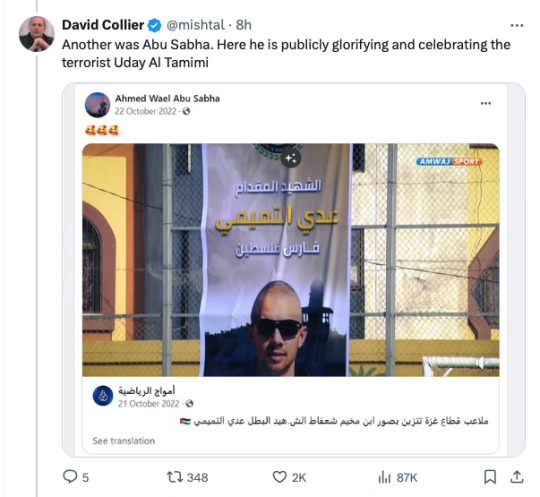

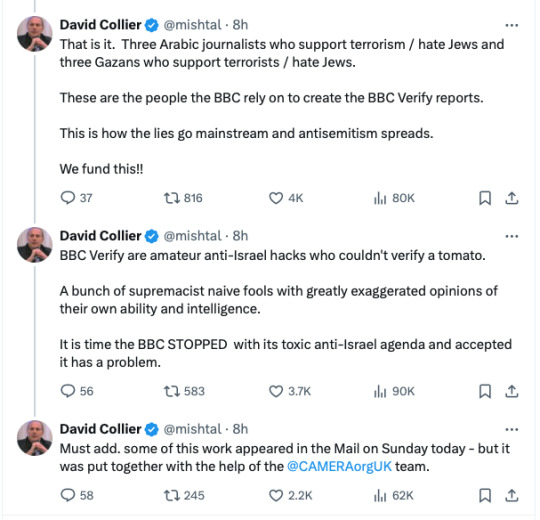
Source
#hamas#gaza#david collier#bbc#bbc verify#abusing palestinian medics#hatem raba#soha ibrahim#abu sabha#bbc news
76 notes
·
View notes
Text
Quis custodiet BBC Verify?
8 notes
·
View notes
Text

323 notes
·
View notes
Text
anyone got that newspaper article about Pat's death to hand? where he's holding the eagle (?) and there's a little bit of info about his life
86 notes
·
View notes
Text
Posting screenshots from The Raggy Dolls every day until ITV puts it on ITVX: Day 27:

#i feel like svt has all the episodes on their equivalent of bbc iplayer#but i can't access it because im not Swedish#can anyone who lives in Sweden verify whether or not its on there for me???#would save me getting a vpn for what could be no reason#the raggy dolls#hi-fi
2 notes
·
View notes
Text
my life would be so much better if my stremio actually had decent torrent sources but no it works on everything except for my fucking phone and I'm not gonna watch my queer ass fantasy shows on the family tv
#i just wanna watch good omens without having to search for a goddamn webbed site that actually fucking works#and like. warrior nun. and these cool looking scifis. and fantasy shows i cant remember right now#like thank god bbc iplayer doesn't verify if you had a tv license because i fucking dont and the amount of doccy who/torchwood i watch#anyway
2 notes
·
View notes
Text
4 notes
·
View notes
Text

There are so many things wrong with this ridiculous blazed post I just saw but the bbc sherlock tag gave me whiplash
#to be fair the full post does mention sherlock (and yes I read through it just to verify that: youre welcome)#but just. scrolling past this clearly religious and bigoted post just to see it tagged as sherlock really made me feel Something#written by the man himself... bbc sherlock#i didnt wanna interact with it past blocking so you get a shitty screenshot bc it was just too funny to not share lmao#i dont mind you sharing your religion on here but Bro#not only are you paying for people that want nothing to do with your post to see it#but youre putting it under a fandom tag?#granted sherlock has a pretty problematic fanbase anyways#but its still pretty fucked up to force your transphobic bullshit onto other people under the guise of 'sharing your faith'
6 notes
·
View notes
Text
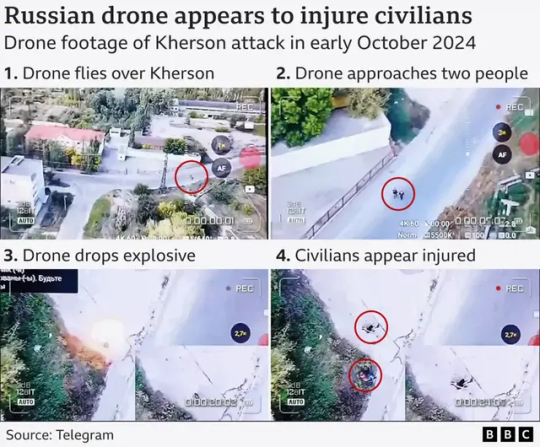
The BBC has finally picked up the story of the "human safari" russians are conducting in Kherson against the residents.
They report that since July 1, the city’s military administration have recorded more than 5,000 drone attacks with more than 400 civilians injured.
[The drone videos] were each posted with goading and threats to the Ukrainian public, including claims that all vehicles were legitimate targets and that people should minimise their public movement. The injured people were also insulted, called "pigs" or in one case mocked for being a woman.
If you want to read the BBC article and share it, you can find it below.
540 notes
·
View notes
Text
by Hadar Sela
On January 30th the BBC News website published a report by BBC Verify headlined “At least half of Gaza’s buildings damaged or destroyed, new analysis shows”.
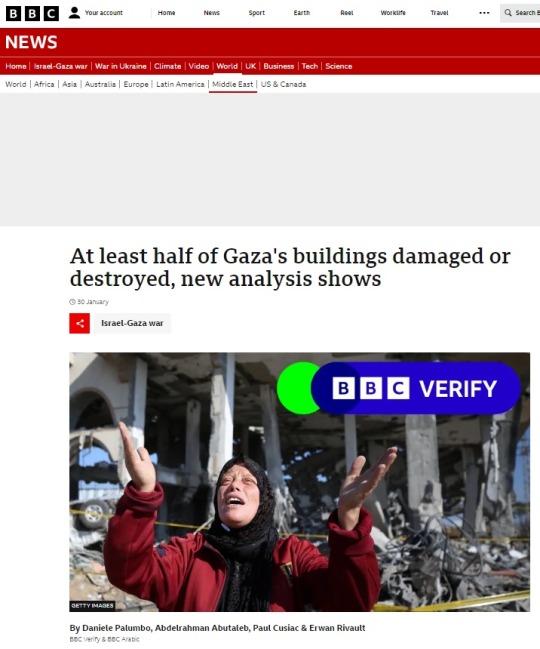
“More than half of Gaza’s buildings have been damaged or destroyed since Israel launched its retaliation for the Hamas attacks of 7 October, new analysis seen by the BBC reveals.
Detailed before-and-after imagery also shows how the bombardment of southern and central Gaza has intensified since the start of December, with the city of Khan Younis bearing much of the brunt of Israel’s military action. […]
Across Gaza, residential areas have been left ruined, previously busy shopping streets reduced to rubble, universities destroyed and farmlands churned up, with tent cities springing up on the southern border to house many thousands of people left homeless. […]
Further analysis, by BBC Verify, reveals the scale of destruction of farmland, identifying multiple areas of extensive damage.”
The information concerning buildings comes from sources who have previously worked with other media outlets to produce similar reports.
“Now, satellite data analysis obtained by the BBC shows the true extent of the destruction. The analysis suggests between 144,000 and 175,000 buildings across the whole Gaza Strip have been damaged or destroyed. That’s between 50% and 61% of Gaza’s buildings.
The analysis, carried out by Corey Scher of City University of New York and Jamon Van Den Hoek of Oregon State University, compares images to reveal sudden changes in the height or structure of buildings which indicate damage.” [emphasis added]
An important clarification concerning that highlighted wording – which is not provided to readers of the BBC Verify report – was given to CAMERA by Jamon Van Den Hoek in late December:
“When we double-checked with the researchers, Van Den Hoek reiterated that they only count structures as “likely damaged or destroyed” because, he explained, “we don’t yet have means of distinguishing categories of damage severity.””
Notably, three days after BBC Verify’s report appeared, the United Nations Satellite Centre – UNOSAT – published its own “assessment of the damage and destruction inflicted on structures in the Gaza Strip” which concluded that 30% (rather than 50% to 61% as claimed by the BBC) of the structures in the territory have been damaged since the beginning of the war. The breakdown given in that report states that 22,131 buildings (9.6% of the total number of structures) have been destroyed, 14,066 (6.1% of the total number of structures) severely damaged and 32,950 (14.3% of the total number of structures) moderately damaged.
The BBC Verify report presents several ‘case studies’, beginning with Khan Younis:
“The southern city of Khan Younis has been particularly badly hit in recent weeks, with more than 38,000 (or more than 46%) of buildings now destroyed or damaged, according to the analysis. Over the past fortnight, more than 1,500 buildings have been destroyed or damaged there.
Al-Farra Tower – a 16-storey residential block in the centre of the city, the tallest building in the area – was flattened on 9 January as can be seen in before-and-after images of the city’s skyline. Much of the neighbourhood in which it sits has been levelled by Israeli attacks since late December.
“Israeli forces targeted residential complexes, especially in the downtown Khan Younis area,” said Rawan Qaddah, a 20-year-old resident, who has been displaced and has lost contact with her family.
She named schools among the many buildings which had been damaged. Some were now being used to house displaced people temporarily.”
Readers are not informed why Rawan Qaddah was selected as a contributor, what qualifies her to provide the information uncritically promoted by the BBC or whether BBC Verify has in fact verified her claim concerning the alleged ‘targeting’ of “residential complexes”.
Moreover, BBC Verify’s report makes no mention of the fact that Israeli forces have been operating in Khan Younis since early December – or why. No mention is made of Hamas command and control centres in that city – which is home to Hamas leader Yahya Sinwar – or of the extensive tunnel network in which some of the Israeli hostages were held, the weapons production sites and rocket launching sites discovered there.
The only attempt to provide box-ticking context after a description and photos of a “damaged restaurant in Khan Younis” reads as follows:
“The IDF has repeatedly justified its actions by noting that Hamas deliberately embeds itself in civilian areas and explained destruction of buildings in the light of targeting fighters.”
Linking to another BBC report on a similar topic, the article goes on to tell readers that:
“Many of Gaza’s historic sites have suffered extensive damage, including the al-Omari Mosque originally built in the 7th Century.”
The context of Hamas’ use of mosques and other supposedly civilian facilities for military purposes and the fact that terrorists were operating in the vicinity of the al-Omari mosque at the time is not provided to readers.
The report then moves on to a section headed “Destruction to Gaza’s farmlands”.
“Further analysis, carried out by BBC Verify, shows large areas of previously cultivated land across Gaza have been extensively damaged.”
A case study is presented:
“BBC Arabic spoke to one farmer, Saeed, who fled south from Beit Lahia, in the north of Gaza, in mid-November.
The 33-year-old grew guava, figs, lemons, oranges, mint, and basil and earned about $6,000 (£5,535) from these crops every year – the only source of income for him, his father and his sister. He had tended to the farm, inherited from his grandparents, for 15 years.
But days after fleeing, he says he was told by a relative that the farm had been destroyed by the IDF, along with five surrounding homes which belonged to his relatives.”
While the exact location of Saeed’s farm is not given, readers would of course have been better placed to put the second-hand claims promoted by BBC Arabic via BBC Verify into context had they been told that Beit Lahia is also the location of a hospital used for terror purposes as well as rocket launching sites and that it is very close to the route of a 4km long, 50 meter deep tunnel discovered by the IDF.
Once again BBC Verify does box-ticking with a minimal response from the IDF:
“The IDF told us it had found Hamas tunnel entrances and rocket launch sites in various agricultural areas, adding that “operational needs require that these places be destroyed or attacked”.
“Environmental damage may be caused as a result of fighting and exchanges of fire.””
There is no doubt that in four months of war, considerable damage has been caused to structures and farmland in the Gaza Strip. One major reason for that is Hamas’ cynical exploitation of civilian homes and civilian infrastructure such as hospitals, universities, schools and mosques for military purposes including missile fire, along with its massive underground tunnel network which compromises the integrity of structures and land above it. Another significant part of the story – completely absent from BBC Verify’s report – is the fact that around 12% of the thousands of missiles launched by Palestinian terrorists have landed in the Gaza Strip.
BBC Verify, however, chose not to provide BBC audiences with that essential background, instead making do with a couple of short, generalised quotes from the IDF in order to tick the impartiality box and preferring to present audiences with a supposedly factual article that is blatantly one-sided and severely lacking in essential context.
15 notes
·
View notes
Text
by Hadar Sela
The cited WHO claim that the Hamas health ministry’s “previous reporting has been credible” does not stand up to scrutiny.
As recently pointed out by Salo Aizenberg, during the 2008/9 three-week conflict, Hamas claimed that just 48 of around 1,300 casualties were combatants. Following an investigation, Israel provided the names of 709 Hamas operatives out of 1,166 casualties. Months later, Hamas admitted that between 600 -700 of its fighters had been killed. After the 2014 conflict, Hamas claimed that 70% of the 2,131 casualties were civilians. Later analysis showed that around 55% of the casualties were combatants.
In addition, BBC Verify makes no effort to inform readers that civilians killed as a result of the actions of terrorist organisations – such as the al Ahli hospital explosion or other incidents involving shortfall missiles – are included in Hamas’ tallies.
Nevertheless, BBC Verify’s report goes on to uncritically quote data provided by a terrorist organisation and – incredibly for a supposed ‘fact checking’ department – to promote assumptions based on that unconfirmed claim:
“The Gaza authorities’ last demographic breakdown from 29 February indicated more than 70% of those killed had been women and children.
So, with the figures suggesting less than 30% of those killed were men – some of whom are likely to be over fighting age – experts have raised questions about how Israel arrived at its claim of killing 10,000 fighters.” [emphasis added]
Get it? BBC Verify’s argument is that if 70% of the around 30,000 people reported killed – i.e. 21,000 – are women and children, then Israel’s “claim of killing 10,000 fighters” cannot be true.
Notably, BBC Verify has nothing to tell readers about the fact that Hamas and other terrorist organisations recruit minors – i.e. individuals who would be classed as children according to the Hamas statistics – beyond a quote from the Israeli embassy in London:
“The Israeli embassy in the UK told us they think the total number of Hamas fighters killed is “between 10,000 and 12,000”.
But they said it was hard to distinguish between civilians and combatants as many of them are not wearing military uniform and Hamas also has fighters who are aged 16 and 17.”
Later in the report, readers discover the identity of one of those experts.
“But some experts are concerned that the IDF might be counting some non-combatants as fighters merely because they are part of the Hamas-run territory’s administration.
Andreas Krieg, a senior lecturer in security studies at Kings College London, said: “Israel takes a very broad approach to ‘Hamas membership’, which includes any affiliation with the organisation, including civil servants or administrators.””
As noted by David Collier, Krieg – who has also been quoted by BBC Verify in relation to a different story – previously worked “as a contractor of the Qatari Armed Forces”. Despite BBC editorial guidelines concerning “contributors’ affiliations”, BBC Verify obviously did not consider it necessary to inform readers of its quoted expert’s previous employment with a state that funds, hosts and supports Hamas.
17 notes
·
View notes
Text
BBC NEWS: A group of 10 innocent men were on their way to burn down a Jewish community center. Those horrible Zionists, instead of letting themselves be burned alive, committed a genocide against those 10 jovial men who also happened to have 60 children with them. The children were all between the ages of 22-35 and were armed with handguns. Their families have started a verified gofundme to help continue their vision of peacefully killing Zionists, wherever those Jews are.
217 notes
·
View notes
Text
F1 Sources
I’ve been asked a few times about what F1 sources I deem as being reliable and here’s a mostly conclusive list
Some of these are particularly reliable for news about certain teams/drivers, and some are all rounders
Magazines/Media Outlets
- AMuS (Auto Motor und Sport), German Motorsport publication, personally my holy grail. Very good for reports on technical stuff.
- Canal+, reliable particularly for Alpine related stuff
- Sky Sports UK, typically don’t comment on rumours until they’re essentially confirmed but sometimes say the wildest shit with no real bearing
- Sky Italia, reliable about Ferrari
- Autosport
- Motorsport.com
People
- Chris Medland, honestly my favourite journalist, he won’t report on anything until it’s verified. Very handy during race weekends
- Giuliano Duchessa, great technical information and also really good for Ferrari news
- Tobi Grüner, AMuS journalist. Does tech stuff but also paddock news
- Albert Fabrega, credible Spanish journalist. Good technical source, especially for upgrades
- Craig Scarborough, excellent technical source
- Andrew Benson, BBC journalist pretty decent information
- Jolyon Palmer, very good technical information (but be aware he is employed by FOM so some things that he says may be influenced by that)
- Erik van Haren, this one is so-so in my opinion. Usually has very accurate news about Red Bull/Verstappen but also has occasionally been used in the past as a mouthpiece of sorts
Less reliable sources (imo)
- ESPN, a bit of a FOM mouthpiece (compared to other sources)
- Lawrence Barretto, FOM employee typically says/writes what they want
- Will Buxton, FOM employee typically says/writes what they want
- Joe Saward, used to be somewhat reliable but recently talks a lot of nonsense
- The Race, sometimes can have good information (particularly things written by Mark Hughes) but a lot is clickbait nonsense
#f1#f101#these are my opinions on decent f1 media sources - if you have others feel free to share them
289 notes
·
View notes
Text


My first thought too. What parents, in a rural setting no less where boys wander and explore, would ever be worried that their 20 year old was “missing” for a couple of hours? And he drives himself. But just because he didn’t answer his phone (allegedly) they called the police?
Nah. Didn’t happen.
But speaking of setting a narrative:

Brass still warm.
BBC just happen to be there.
Guys lays out the single shooter story in a televised interview.
Maybe maybe not.
Verify everything. We may never know the truth though. The lies, cover up and incompetence have gone radioactive
88 notes
·
View notes
Text
Six months into the Russian occupation of the Ukrainian city of Kherson, in September 2022, the director of Liza Batsura’s college arrived at the dormitory where Batsura lived and told the students to pack up their things: They were going to Crimea. If the students refused, they would be put in the basement, Batsura said, speaking through a translator. The director gave no further explanation.
The next evening, they were taken to a camp called “Friendship” in Crimea, which was occupied by Russia in 2014. Although she couldn’t have known it at the time, Batsura—now 16 years old—was one of almost 20,000 children the Ukrainian government estimates have been deported or forcibly displaced to Russia. Only 388 have been returned.
Initially, the prospect of a couple of weeks by the sea didn’t sound so bad. But Batsura quickly began to realize that that wouldn’t be the case. The food was terrible, the days were long, and the children were pressured to sing Russian songs, including the national anthem, which made her very uncomfortable.
Foreign Policy is unable to independently verify Batsura’s account, but her experience closely tracks with the findings of investigations by the United Nations as well as researchers at Yale School of Public Health and other human rights groups who have documented a “systematic” effort to relocate and reeducate thousands of Ukrainian children over the course of the war. She also recounted her story to Reuters as part of an extensive investigation into the deportations.
Batsura was one of five Ukrainian teenagers who visited Washington last month with representatives of Save Ukraine, a Ukraine-based nonprofit that helps to rescue Ukrainian children from Russia and the territories it occupies. They stoically recounted the stories of their abductions again and again for journalists, members of Congress, and attendees at public events.
It was the group’s first visit to Washington. Batsura felt like she was in a movie, she said.
With long limbs and round cheeks, the teenagers filed into the conference room of a Washington-based nonprofit with their minders from Save Ukraine for an interview with Foreign Policy. Once the Wi-Fi password had been secured and the bathroom located, they began to tell their stories.
They were teenagers like any other you’d see hanging out with friends at a cafe or shopping mall. Yet they were also victims of Moscow’s large-scale deportation of Ukrainian children—a potential war crime and the reason that the International Criminal Court (ICC) issued arrest warrants for Russian President Vladimir Putin and the country’s children’s rights commissioner, Maria Lvova-Belova, in March 2023.
Like Batsura, they all hail from regions of eastern Ukraine that were quickly occupied by Russian forces in the early days of the war. They recount being coerced or forced, sometimes at gunpoint, to go with Russian forces, and they were taken to schools and summer camps where they were held for several months and faced pressure to accept Russian citizenship.
In many instances, Ukraine’s most vulnerable children have borne the brunt of Russian deportation. Before the war, Ukraine had one of the highest rates of child institutionalization in Europe, with more than 100,000 children living in residential institutions. The vast majority have living parents but were placed in institutions because of poverty, difficult family circumstances, or because the child had a disability, according to Human Rights Watch.
The deportations have been carried out in plain sight. Early in the war, Putin signed a decree making it easier for Ukrainian children to be adopted and to be given Russian citizenship. Lvova-Belova herself claims to have adopted a teenager from the besieged Ukrainian city of Mariupol, and she has spoken publicly about her efforts to Russify him. In November, a BBC investigation found that a 2-year old girl who went missing from a children’s home in Kherson when she was just 10 months old had been adopted by 70-year-old member of the Russian parliament, Sergey Mironov.
Lvova-Belova has made a number of visits to institutions holding Ukrainian children, including to a college in the occupied Ukrainian city of Henichesk, where Batsura had been transferred from Crimea and placed in a culinary arts program.
The dormitory where Batsura was placed was freezing cold at night, she said, and the teenagers were forbidden to close the doors to their rooms. Russian troops patrolled the halls.
Lvova-Belova offered the children 100,000 rubles, roughly $1,000, and the opportunity to study at a college in Russia on the condition that they remain there. Batsura refused. Officials tried to find her a foster family, and she feared she would be sent to a remote region of Russia and would never be able to return to Ukraine.
For eight months while she was in Russian custody, Batsura had been unable to contact her mother, but she learned through a friend that her mother was working with Save Ukraine and applying for a passport so that she could travel to Russia and collect her.
With the border to Russia closed since the invasion, families face a daunting overland journey through wartime Ukraine, traveling into Poland, Belarus, and then Russia and—in Batsura’s case—down into occupied Ukrainian territory.
In some instances, children are turned over to their relatives without too much difficulty once the family members arrive to collect them, but the Russian authorities have also been known to present obstacles, said Olha Yerokhina, a spokesperson for Save Ukraine. The organization has helped families retrieve 240 children to date.
Officials at the school told Batsura that the journey was too arduous and that her friend was giving her false hope that her mother would ever arrive. “I didn’t believe them, and I kept telling myself that ‘No, my mom can do it, my mom will come,’” she said.
In May 2023, Batsura was rescued by her mother and now lives with her in Kyiv, where she is working with psychologists to process her experience. She is back in school and describes her hobbies as writing poems and making TikTok videos.
I asked her, given the atrocities that Putin has been accused of committing in Ukraine and during his presidency, how she felt about the fact that it was experiences like hers that had led the ICC to issue an arrest warrant for the Russian leader.
Yerokhina, who acted as our translator, interrupted to say that because she was rescued after the court order was issued, Batsura had likely missed the news about the ICC arrest warrant.
After Yerokhina explained the court’s decision, Batsura said, “It’s just.”
149 notes
·
View notes